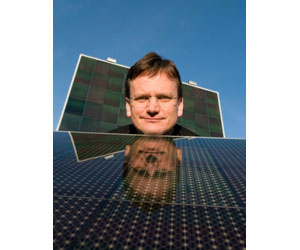- Wednesday, June 18, 2008 Latest Update: 1:53PM
Greentech Solar
Solar
Jennifer Kho June 18, 2008 6 CommentsNanosolar Creates Largest Thin-Film Tool
The company says that its coater can produce up to1 gigawatt of solar cells each year, potentially cutting manufacturing costs by two orders of magnitude.

Nanosolar said Wednesday it has created the industry’s largest solar production tool: a thin-film coater that has the capacity to produce up to 1 gigawatt of solar cells annually.
That compares with 10 to 30 megawatts of annual production capacity for most solar production tools, CEO Martin Roscheisen wrote on the company’s blog.
The tool, which uses the Nanosolar’s nanoparticle ink, costs $1.65 million and – at the speed at which it’s currently running, 100 feet per minute -- produces cells for a hundred times less than a high-vacuum process, he wrote.
Roscheisen, who also included a video of the tool in his post, said the company expects the tool to have the potential to reach speeds of up to 2,000 feet per minute.
He added that the tool delivers cells that can convert sunlight into electricity with up to 14.5 percent efficiency, but declined to answer a question about the average efficiency of the cells that are being produced.
Nanosolar in December announced it had begun production at its San Jose, Calif., facility. The company said in 2006 that the factory would have the capacity to produce 430 megawatts of cells, but it hasn’t discussed its actual production numbers since December. Nanosolar is also building a panel assembly facility in Germany.
Roscheisen told Greentech Media on Wednesday that all of Nanosolar’s initial production will be based on the new tool.
“Innovative nonvacuum thin-film process technology has become reality a lot quicker than anyone thought it would be possible – and at leapfrogging scale!” he said in an email.
Paul Maycock, president of solar-electric consulting and research firm Photovoltaic Energy Systems, said the announcement, if true, is very important.
After all, manufacturing costs for thin-film leader First Solar’s cadmium-telluride films are about $1 per watt, he said. That would equate to $1 billion for a gigawatt, with everything included.
While Nanosolar’s $1.65 million wouldn’t include the costs for the whole line, but just for one tool, it implies a “very significant” cost reduction, Maycock said.
“If they’ve got that, they’ve got the world by the tail,” he said. “It sounds like a major accomplishment, but the proof is in the product.”
Maycock warned that an announcement isn’t proof, and added that Nanosolar has been putting out press rele ases for years. In 2006, the company said it planned to reach mass production in 2007 (see Nanosolar to Build in San Jose).
“When are they going to have products?” he asked. “When can I buy them? Show me a product that I can check the efficiency of and can get for $2 or less. I have to adopt a ‘show me’ attitude with Nanosolar, but I don’t say they can’t do it – I hope they do. We need 14 percent thin films with prices below $2 a watt right now.”
Roscheisen said the company isn't yet in normal volume production and isn't releasing any volume forecasts.
The company already has products commercially available to its existing customers and is starting work on a second 5-megawatt solar farm, in addition to the 1-megawatt farm it announced in December for its first customer, Beck Energy, he said.
Most Popular
-
Solyndra Works on 1M Sq. Ft. Project in SoCal
July 16, 2009 -
True or False: China Will Be a Bigger Solar Market than the U.S.
July 17, 2009 -
Boom Time Ahead for U.S. Solar Manufacturing, Says Analyst
July 14, 2009 -
Solar Alchemy: Voltaix Gets $9M for Thin-Film Chemicals
July 16, 2009
Articles
-
Solyndra Works on 1M Sq. Ft. Project in SoCal
July 16, 2009 11 Comments -
A Moore's Law for Solar
July 10, 2009 4 Comments -
Boom Time Ahead for U.S. Solar Manufacturing, Says Analyst
July 14, 2009 3 Comments -
True or False: China Will Be a Bigger Solar Market than the U.S.
July 17, 2009 3 Comments
Discussions
-
Intelligent Energy Snags $30M for Fuel Cell Deployment
Ucilia WangJuly 21, 2009 -
Fuel Cells as Renewable Power?
Jeff St. JohnJuly 20, 20091 comments -
High-capacity Capacitor Stirring Up Automakers' Interest
Oka Tai-LeeJuly 17, 2009
-
eMeter Lands $32M for Smart Meter Data, Home Energy Software
Jeff St. JohnJuly 22, 20091 comments -
DOE Hands Out $47M for Smart Grid Demos
Jeff St. JohnJuly 20, 2009 -
8.3M Smart Meters and Counting in U.S.
Jeff St. JohnJuly 17, 2009
-
Enviance to Help 12 Military Bases Manage Carbon Footprint
Jeff St. JohnJuly 21, 2009 -
Samsung to Go Green, Others Will Follow
Ucilia WangJuly 20, 2009 -
The Problem With Carbon Footprints
Michael KanellosJuly 20, 20092 comments
Comments [6]